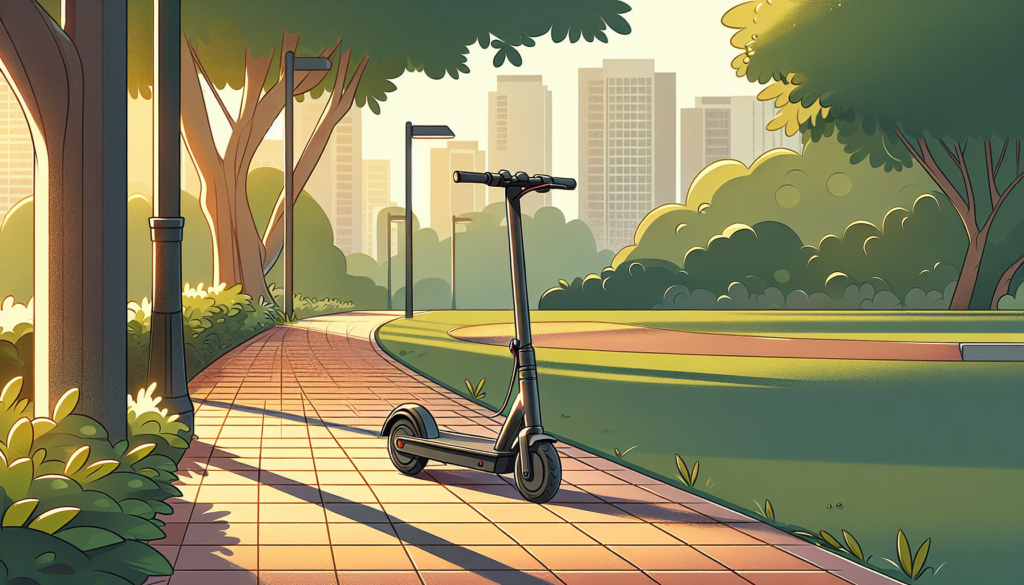
In recent years, electric scooters have gained immense popularity as a convenient and eco-friendly mode of transportation, particularly in urban settings. In Malaysia, especially in bustling cities like Petaling Jaya and Kuala Lumpur, the potential for electric scooters to revolutionize food delivery is becoming increasingly apparent. With their ability to navigate through congested traffic and access narrow streets, electric scooters present a viable option for delivery services aiming to enhance efficiency while reducing their carbon footprint. As we delve into the benefits and drawbacks of utilizing e-scooters for food delivery, it becomes essential to explore how this innovative approach can not only streamline operations but also contribute positively to the environment and local economy.
Overview of Food Delivery Landscape in Malaysia
The food delivery landscape in Malaysia has witnessed exponential growth over the past few years, driven by a demanding consumer base and an increasing appetite for convenience. Urban areas such as Petaling Jaya and Kuala Lumpur are bustling hubs where people are constantly on the move, leading to a heightened reliance on efficient delivery services. With traditional delivery methods often encumbered by traffic congestion and parking issues, the introduction of electric scooters presents a viable alternative to cater to the city’s fast-paced lifestyle.
Electric scooters not only offer a nimble way to navigate through crowded streets, but they are also environmentally friendly, aligning with the global trend towards sustainability. However, like any other delivery method, using electric scooters for food delivery has its pros and cons. On the positive side, electric scooters are cost-effective, allowing delivery services to save on fuel and maintenance expenses, while providing quick and reliable service to customers. They have a smaller carbon footprint, which appeals to eco-conscious consumers.
On the flip side, there are challenges such as limited storage space, exposure to weather conditions, and the need for competent riders who can maneuver through urban traffic safely. Balancing these factors is crucial for optimizing the potential of electric scooters in the Malaysian food delivery market.
The Advantages of Using Electric Scooters for Delivery
Electric scooters are quickly becoming a popular choice for food delivery services in Malaysia, particularly in bustling cities like Petaling Jaya and Kuala Lumpur. The city’s high population density, coupled with the growing demand for fast and efficient delivery, makes electric scooters an appealing option. Not only are they eco-friendly, producing zero emissions, but they also maneuver easily through congested streets, allowing for quicker deliveries. Additionally, their low operational costs and reduced maintenance requirements compared to traditional vehicles provide an attractive incentive for delivery businesses looking to maximize profit while minimizing environmental impact.
However, while there are significant advantages to using electric scooters for food delivery, there are also some downsides to consider. For instance, the limited range of most electric scooters may restrict the distance delivery riders can travel from their base. Also, in adverse weather conditions, challenges such as reduced visibility and slippery roads can pose risks to safety. Furthermore, the initial investment for high-quality electric scooters, along with the need for maintenance and charging infrastructure, can be a barrier for some businesses. Balancing these pros and cons is essential for delivery services to make informed decisions about adopting electric scooters in their operations.
Challenges Faced by Electric Scooter Delivery Services

Electric scooter delivery services in Malaysia face several challenges, particularly in densely populated areas like Petaling Jaya and Kuala Lumpur. One significant hurdle is navigating through heavy traffic and congested streets, which can delay deliveries. Additionally, the lack of dedicated bike lanes can pose safety risks for scooter riders, making it difficult for them to maneuver alongside larger vehicles. Weather conditions also play a crucial role; rain and extreme heat can deter riders from using electric scooters, affecting their ability to fulfill delivery requests promptly.
Key Features of Electric Scooters for Food Delivery
Electric scooters have become increasingly popular as a viable option for food delivery in Malaysia, particularly in densely populated areas like Petaling Jaya and Kuala Lumpur. One of the key features that make electric scooters ideal for this purpose is their ability to navigate through congested urban settings, allowing delivery riders to bypass traffic and reach their destinations more quickly. With a compact design and lightweight structure, electric scooters can easily maneuver through narrow streets and crowded sidewalks, making them perfect for delivering food items efficiently.
Additionally, many modern electric scooters are equipped with robust carrying compartments, which can comfortably accommodate food orders while ensuring that they remain intact and at the right temperature during transport. Furthermore, the eco-friendliness of e-scooters cannot be overlooked. With the growing concern about environmental sustainability, the use of e-scooters reduces carbon emissions associated with traditional petrol-based delivery vehicles. This appeal is particularly relevant in today’s market, where consumers are more environmentally conscious.
However, it’s essential to consider the pros and cons. While electric scooters are often affordable and efficient, they may also face limitations such as range anxiety and battery life, which can affect delivery times. Despite these challenges, the benefits of using e-scooters for food delivery in Malaysia are undeniable, making them an increasingly attractive option for businesses and delivery personnel alike.
Environmental Impact of Food Delivery via Electric Scooters
The use of electric scooters for food delivery in Malaysia presents a significant opportunity to reduce the carbon footprint associated with traditional delivery methods. With densely populated urban areas like Petaling Jaya and Kuala Lumpur facing traffic congestion and pollution, electric scooters provide an eco-friendly alternative. By relying on electric power rather than fossil fuels, these scooters contribute to lower greenhouse gas emissions, improving air quality in cities. Additionally, e-scooters require less energy to operate compared to gas-powered vehicles, enhancing the sustainability of food delivery services.
This shift not only supports environmental initiatives but also aligns with the growing consumer demand for green solutions in delivery services. However, while the benefits are clear, there are potential drawbacks to consider. The versatility of electric scooters can be compromised by limited battery range and the availability of charging infrastructure in urban areas. Weather conditions also pose challenges, as heavy rain or storms can hinder delivery times and affect rider safety. Thus, while e-scooters hold great promise for revolutionizing food delivery in Malaysia, it is essential for both providers and customers to be aware of these limitations as they navigate this new landscape.
Future Trends in Electric Scooter Delivery in Malaysia
The future of food delivery in Malaysia is poised for a significant transformation with the rise of electric scooters. As cities like Petaling Jaya and Kuala Lumpur continue to experience rapid urbanization, the need for efficient and eco-friendly delivery methods becomes increasingly critical. E-scooters offer a compelling answer to this demand, boasting benefits such as reduced delivery times and lower operational costs. Not only do these scooters navigate through congested traffic more easily than traditional delivery vehicles, but they also provide an environmentally friendly alternative, appealing to the growing population of environmentally conscious consumers.
Additionally, the ability for restaurants to rely on electric scooters can lead to increased customer satisfaction, ensuring food arrives fresh and promptly, making it a viable option for the Malaysian food delivery scene. However, while the advantages of using e-scooters for food delivery are numerous, there are also challenges to consider. One major con is the limited range and battery life of these e-scooters, which may restrict deliveries to a certain radius. This can pose logistical challenges for restaurants aiming to serve a wider area.
Furthermore, safety concerns and infrastructure limitations, such as inadequate bike lanes, could hinder the effectiveness of electric scooters in high-traffic areas. Balancing these pros and cons will be crucial as Malaysia embraces this trend, ultimately determining how these e-scooters can play a vital role in shaping the future of food delivery in urban locales.
The Future of Food Delivery in Malaysia: Embracing Electric Scooters

In conclusion, electric scooters present a promising and efficient alternative for food delivery services in densely populated areas like Kuala Lumpur and Petaling Jaya. Their ability to navigate through heavy traffic, coupled with lower operational costs and reduced environmental impact, makes them an appealing option for both delivery riders and businesses. By adopting e-scooters with us at EKO Life MY, food delivery services can enhance their overall efficiency and reliability, ensuring that customers receive their meals in a timely manner while contributing to a greener economy.
However, it is essential to consider the pros and cons of using electric scooters for food delivery. While they offer versatility and cost-effectiveness, factors such as battery range, maintenance, and safety on the busy roads must not be overlooked. By addressing these challenges and investing in proper infrastructure, the food delivery sector in Malaysia has the potential to benefit significantly from the integration of e-scooters into their operations.

I think the article highlights the potential impact of electric scooters in transforming the food delivery industry in Malaysia. The use of electric scooters seems like a game-changer, especially in congested cities like Kuala Lumpur.
We’re glad you found the article informative and thought-provoking, Yvonne. At Eko Life Malaysia, we believe that electric scooters can indeed be a game-changer for the food delivery industry in Malaysia. Our team is always looking for ways to provide the best e-bikes, ebikes, and electric scooter services in Malaysia, and we’re happy to hear that our content is sparking valuable discussions. If you have any further questions or would like to know more about our products and services, please don’t hesitate to reach out to us at [email protected] or call us at +60 3-7890 3042.
I agree with the author that electric scooters are cost-effective and offer quick service. However, I worry about safety and the exposure of riders to harsh weather conditions. Malaysia should invest in better infrastructure for electric scooters.